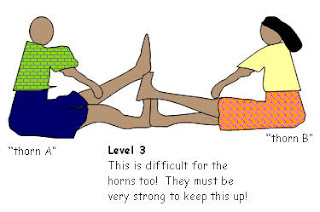Minimum number of players: usually 3 but 2 can also work (more players is usually much more fun!)
Equipment required: a grassy field with lots of room to run and tumble
First children decide among themselves who will play first and who will be the two who will act as the “thorns” in the game. Thorns have a very important as well as difficult task in the game. Jumpers take turns passing the levels. The jumpers form a queue and the thorns take their position.
The “thorns” (A & B) sit, facing each other with the soles of their feet touching. This is the first level that jumpers must successfully jump through without touching any of their body parts with those of the thorns’ body parts.

Next level the two thorns must adjust their distance a bit towards each other so they can comfortably and successfully create level 2, where one of “thorn A’s” foot is used as base, and another of “thorn B’s” foot as the second level above the base.

Then it is thorn A’s foot as base, thorn B’s foot as second layer of base then thorn A’s other foot as 3rd level.

Then is is both A and B’s feet alternating to create level 4. Then it is all four feet plus thorn A’s hand: Level 5. A & B’s feet and one hand each: Level 6. A& B’s feet and two of A’s hands and B’s one hand: Level 7. Finally Level 8 has all four hands and feet alternating.

Successful jumpers are cleared and pass on to the next level. The group decides how many tries will be given for each attempt. For example, you get one more try. So if you were unsuccessful the first attempt, you step aside and wait till everyone has their turn jumping over the “thorns”.
After this, all the unsuccessful ones take their second attempt. If you still did not clear that level, you are out of the game and spend the remaining time watching the rest of the kids complete all the rounds. Then you are candidate for the thorns so that the thorns of the current game can take their turn as jumpers in the next game.





